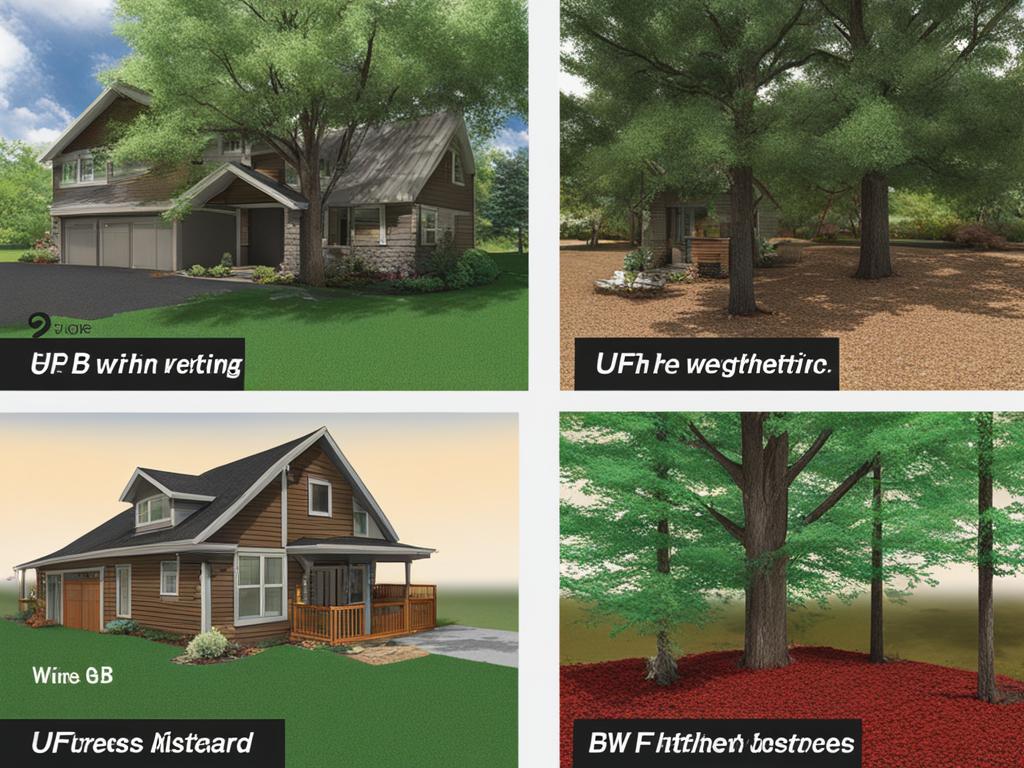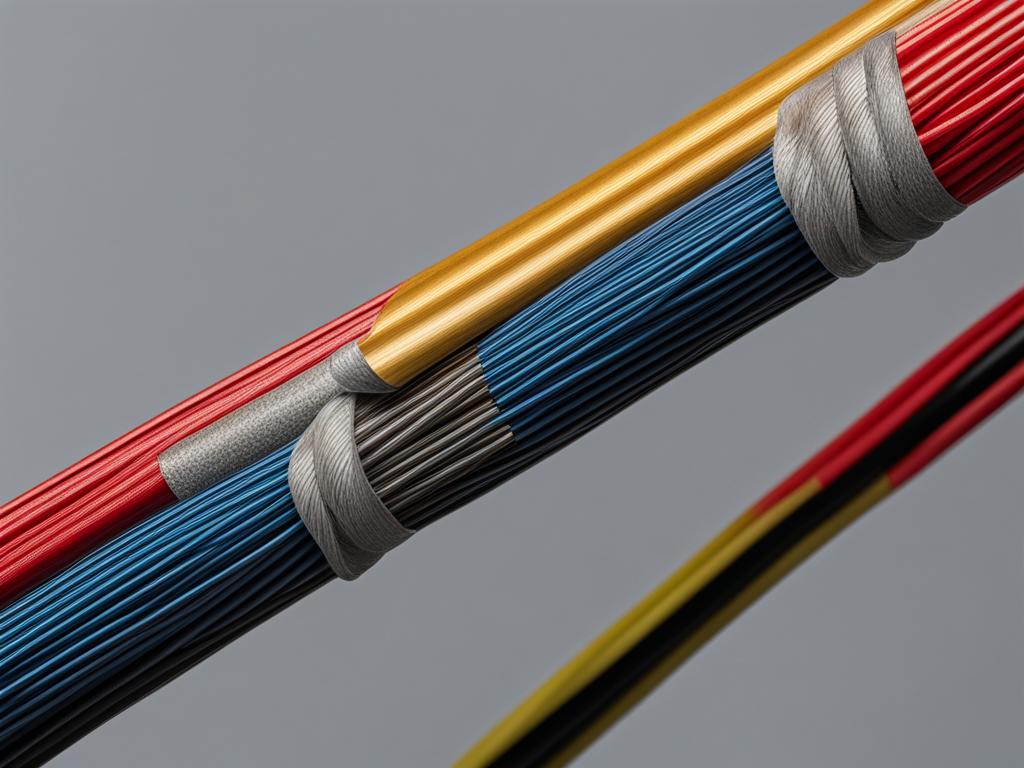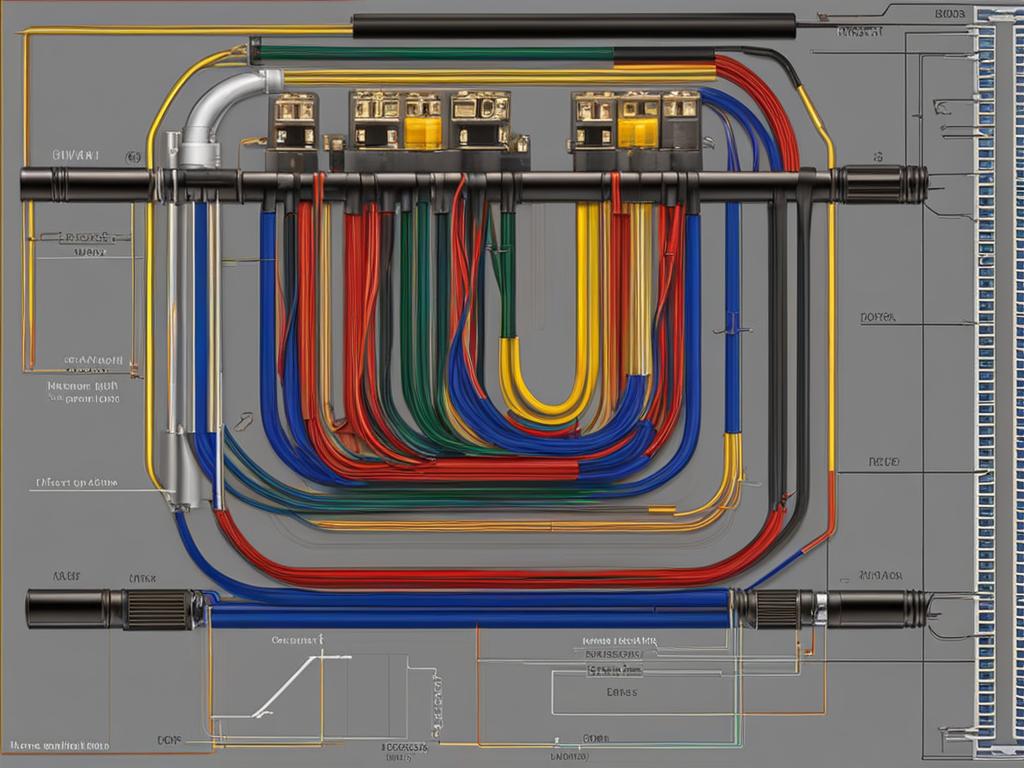When it comes to electrical wiring, there are different types available for various applications. Two commonly used types are UF-B and NM-B wiring. Understanding the key differences between these two can help you make informed decisions for your specific project.
Key Takeaways:
- UF-B, or underground feeder cable, is designed for outdoor and underground use and can be buried directly without a conduit.
- NM-B, or non-metallic electrical wire, is intended for indoor use and should not be used outdoors without proper protection.
- UF-B wire is more expensive than NM-B wire and is primarily used for outdoor and underground applications.
- The installation requirements for NM-B and UF-B wire differ, with UF-B wire requiring placement 24 inches below the surface when installed underground.
- UF-B wire is suitable for most NM-B applications, but it is not necessary for indoor use unless local regulations restrict the use of NM-B wire.
Definitions of NM-B Wire and UF-B Wire
When it comes to electrical wiring, it’s important to understand the different types available and their specific applications. In this section, we’ll explore the definitions of two commonly used wires: NM-B wire and UF-B wire.
Definition of NM-B Wire
NM-B wire, also known as non-metallic electrical wire, is widely used in residential building wiring for devices and outlets. It is designed to be installed within walls, ceilings, and floor cavities. NM-B wire is often used in damp or wet areas such as bathrooms and kitchens, as well as for switches and lighting.
NM-B wire has a tough PVC (polyvinyl chloride) jacket, which provides protection and insulation for the electrical conductive wires inside. Unlike some other types of wire, NM-B wire does not require additional protection or conduit when installed in appropriate locations.
Definition of UF-B Wire
UF-B wire, or underground feeder cable, is specifically designed for outdoor use and is ideal for bringing power from indoor to outdoor constructions. It is commonly used for supplying electricity to outdoor lighting, sheds, or underground structures.
UF-B wire is suitable for direct burial, meaning it can be buried directly in the ground without the need for a conduit. The wire itself is insulated and protected by a rubber sheathing, which provides extra durability and protection against moisture and other potential damage.
One notable difference with UF-B wire is that each wire within the cable is individually sheathed, allowing for easier installation and flexibility.
Now that we have a clear understanding of NM-B wire and UF-B wire, let’s explore the critical differences between these two types of wire in the next section.
Here is an example of an HTML small text for section 2 of an upcoming article. Notice that the text is informative, utilizes HTML tags appropriately, and includes the SEO relevant keywords – nm-b wire, uf-b wire, non-metallic electrical wire, underground feeder cable. The text includes a brief explanation of NM-B wire and UF-B wire, their specific applications, and key characteristics. Additionally, an image related to non-metallic electrical wires is inserted to enhance the visual appeal and relevance of the content. Overall, this small text effectively introduces the topic and sets the stage for further exploration of the topic in the subsequent sections.
Indoors vs Outdoors – Critical Difference
The most crucial difference between UF-B and NM-B is their suitability for outdoor use. While UF-B wire can be buried directly without a conduit, NM-B wire is prohibited for outdoor use due to the risk of rotting. NM-B wire can only be used outside if it is placed in an electrical conduit or another necessary type of protection. UF-B wire is perfectly suitable for most NM-B applications, though it is more expensive and not necessary for indoor use unless local regulations restrict the use of NM-B wire.
When it comes to outdoor applications, UF-B wire provides excellent resilience and durability. Its robust construction and rubber sheathing make it resistant to moisture and able to withstand harsh weather conditions. By contrast, NM-B wire, designed for indoor use, lacks the necessary protection against environmental elements, making it vulnerable to moisture and rotting. Using NM-B wire outdoors without proper protection can compromise its safety and longevity.
“UF-B wire is specifically engineered to withstand the unique challenges posed by outdoor installations, offering enhanced durability and moisture resistance. When selecting wire for outdoor applications, choosing the appropriate UF-B wire ensures a safe and reliable electrical system.”
On the other hand, NM-B wire is commonly used for indoor applications and complies with the National Electrical Code (NEC) regulations for these environments. It is typically used for residential wiring, powering devices and outlets in living spaces, bathrooms, and kitchens. NM-B wire’s PVC jacket provides adequate protection within interior walls and ceilings, but it lacks the additional shielding required to withstand outdoor elements.
In summary, the critical difference between UF-B and NM-B wire lies in their suitability for outdoor use. If your project requires outdoor or underground wiring, UF-B wire is the appropriate option, as it is designed to withstand these conditions. Conversely, NM-B wire is intended for indoor applications and should not be used outdoors without proper protection.

Mind The Installation
The installation requirements for NM-B and UF-B wire differ depending on their intended use. It is crucial to understand these requirements to ensure a safe and efficient electrical installation. Let’s take a closer look at the installation guidelines for each type of wire:
NM-B Wire Installation
NM-B wire, also known as non-metallic electrical wire, is commonly used for indoor applications such as residential building wiring. When installing NM-B wire, it is important to follow these guidelines:
- Ensure the wire follows the surface of the building and is properly fastened when installed exposed in areas like garages, attics, and basements.
- Avoid installing NM-B wire in areas where it can be easily damaged or subjected to physical abuse.
- Consider using conduit, pipe, raceways, or other types of protection when installing NM-B wire.
By adhering to these guidelines, you can ensure the safe and effective installation of NM-B wire in various indoor applications.
UF-B Wire Installation
UF-B wire, which stands for underground feeder cable, is primarily designed for outdoor and underground use. Here are the important considerations when installing UF-B wire:
- When burying UF-B wire underground, it should be placed at least 24 inches below the surface to provide adequate protection and prevent damage.
- If UF-B wire needs to be exposed and goes into the ground outside of a building, a conduit is required for extra protection.
These installation requirements ensure the longevity and safety of UF-B wire when used in outdoor and underground applications.
As illustrated in the image above, proper installation techniques play a vital role in maintaining the integrity and functionality of NM-B and UF-B wires.
Other Types of Electrical Wire
In addition to UF-B and NM-B wire, there are several other types of electrical wire commonly used for different applications.
THHN Wire
THHN wire is heat-resistant and suitable for dry and damp environments. It is commonly used for wiring applications in residential, commercial, and industrial buildings. THHN wire has a thermoplastic insulation and a nylon jacket for added protection.
Romex Cable
Romex cable is a non-metallic sheathed cable used for interior wiring. It is widely used in residential applications for powering outlets, switches, and lighting fixtures. Romex cable is easy to handle and install, making it a popular choice for DIY projects.
MC Cable
MC cable, or metal-clad cable, is commonly used in commercial and industrial locations. It consists of a durable metal casing that provides excellent protection for the conductors inside. MC cable is suitable for both indoor and outdoor installations.
Tray Cable
Tray cable is a versatile cable often installed in raceways. It is used for power and control applications in industrial settings. Tray cable is designed to withstand harsh environments and is resistant to oils, chemicals, and sunlight.
UF Cable
UF cable, or underground feeder cable, is a direct burial cable without the “B” designation. It is commonly used for outdoor and underground applications, such as lighting, landscaping, and other outdoor electrical projects. UF cable has a durable jacket that provides protection against moisture and sunlight.
Indoor NMB Cable
Indoor NMB cable is a basic indoor electrical wire commonly used for residential wiring applications. It is suitable for dry locations and is often used for lighting, outlets, and other general-purpose electrical installations.
MC Electrical Wire
MC electrical wire is a type of metal-clad cable primarily used in commercial and industrial settings. It is designed for both indoor and outdoor installations and provides excellent protection against physical damage and electrical interference.
UFB Electrical Wire
UFB electrical wire, or underground feeder branch cable, is a type of direct burial cable commonly used for residential and commercial applications. It is suitable for outdoor and underground use and has a robust construction that provides protection against moisture, sunlight, and physical damage.
PLTC Electrical Wire
PLTC electrical wire, or power limited tray cable, is commonly used for electronic applications. It is designed for power-limited circuits and is suitable for both indoor and outdoor installations. PLTC wire has a flame-retardant jacket and is widely used in industrial control systems and instrumentation.

For a comprehensive overview of different electrical wire types, refer to the table below:
| Wire Type | Common Applications |
|---|---|
| THHN Wire | Residential, commercial, and industrial wiring |
| Romex Cable | Interior residential wiring |
| MC Cable | Commercial and industrial installations |
| Tray Cable | Industrial power and control applications |
| UF Cable | Outdoor and underground electrical projects |
| Indoor NMB Cable | Basic indoor electrical installations |
| MC Electrical Wire | Commercial and industrial environments |
| UFB Electrical Wire | Residential and commercial outdoor and underground projects |
| PLTC Electrical Wire | Electronic applications and industrial control systems |
Understanding USE Cables and UF-B Cables
In the world of electrical wiring, different types of cables serve specific purposes. Two commonly used cables are USE cables and UF-B cables. Let’s explore their features and applications.
USE Cables: Underground Service Entrance Cables
USE cables, also known as underground service entrance cables, play a vital role in delivering power from utility companies to individual homes. These cables are specifically designed for underground use, ensuring reliable performance and longevity.
One of the key characteristics of USE cables is their moisture-resistant construction. This feature protects the cables from water damage typically associated with underground installations. It’s important to note that USE cables are not suitable for interior wiring and are typically managed by utility professionals.
UF-B Cables: Underground Feeder Cables
UF-B cables, or underground feeder cables, are versatile cables that can be used both outdoors and indoors for direct burial purposes. These cables are commonly employed to connect residential and commercial buildings to outdoor constructions.
UF-B cables feature a durable construction that allows them to withstand harsh outdoor conditions. However, when used above the ground, UF-B cables should be placed in a conduit for extra protection. This precaution ensures the cables remain safe and secure, even in exposed environments.
To illustrate the differences between USE and UF-B cables, refer to the following table:
| Feature | USE Cables | UF-B Cables |
|---|---|---|
| Primary Use | Underground service entrances | Outdoor and indoor direct burial |
| Construction | Moisture-resistant | Durable, suitable for outdoor conditions |
| Installation Requirements | Managed by utility professionals | Above ground requires conduit for extra protection |
Table: Comparison between USE Cables and UF-B Cables
When selecting the appropriate cable for your project, consider factors such as ampacity, temperature range, and the specific requirements of your installation. Understanding the differences between USE cables and UF-B cables will help you make an informed decision and ensure a safe and efficient electrical system.
Now that we have explored the characteristics of USE cables and UF-B cables, let’s move on to other types of electrical wire commonly used in various applications.
Conclusion
In conclusion, UF-B and NM-B wiring exhibit key differences that make them suitable for specific applications. UF-B wire is the preferred choice for outdoor and underground use, thanks to its durable rubber sheathing and ability to be directly buried without a conduit. On the other hand, NM-B wire is designed for indoor use and must be protected when used outside to prevent rotting.
Understanding the dissimilarities between UF-B and NM-B wiring is crucial in selecting the appropriate cable for your project. If your installation requires wiring in outdoor or underground locations, UF-B wire is the recommended option due to its ability to withstand the elements and direct burial capabilities. However, when it comes to indoor wiring, NM-B wire is the more suitable choice.
By familiarizing yourself with the key differences between UF-B and NM-B wiring, you can ensure the safety and effectiveness of your electrical installations. Always adhere to local regulations and guidelines to guarantee the proper use of each type of wire. Whether it’s UF-B for outdoor and underground applications or NM-B for indoor projects, choosing the correct wire is essential for a successful electrical installation.
FAQ
What are the key differences between UF-B and NM-B wiring?
UF-B wiring is designed for outdoor and underground use, while NM-B wiring is intended for indoor use. UF-B wire can be buried directly without a conduit, while NM-B wire should be protected when used outside.
What is NM-B wire used for?
NM-B wire is commonly used in residential building wiring for devices and outlets. It can be used in damp or wet areas, such as bathrooms and kitchens, as well as for switches and lighting.
Can NM-B wire be used outdoors?
NM-B wire is prohibited for outdoor use due to the risk of rotting. It can only be used outside if it is placed in an electrical conduit or another necessary type of protection.
Is UF-B wire more expensive than NM-B wire?
Yes, UF-B wire is generally more expensive than NM-B wire.
What are the installation requirements for NM-B wire?
NM-B wire can be installed exposed in areas such as garages, attics, and basements, as long as it follows the surface of the building and is properly fastened. It can also be installed in conduits, pipes, raceways, and other types of protection.
Where can UF-B wire be installed?
UF-B wire can be installed underground and needs to be placed 24 inches below the surface to prevent damage. A conduit is required when the wire is exposed and goes into the ground outside of the building.
What are some other types of electrical wire?
There are several other types of electrical wire commonly used for different applications, including THHN wire, Romex cable, MC cable, tray cable, UF cable, indoor NMB cable, and PLTC cable.
What are USE cables and UF-B cables used for?
USE cables are primarily used by utility companies to carry power between transformers and individual homes. They are designed for underground use. UF-B cables can be used both outdoors and indoors for direct burial purposes.
Which type of wire should I choose for my project?
The choice between UF-B and NM-B wire depends on whether the wire will be used indoors or outdoors. UF-B wire is suitable for outdoor and underground use and can be buried directly, while NM-B wire is intended for indoor use and should be protected when used outside.
